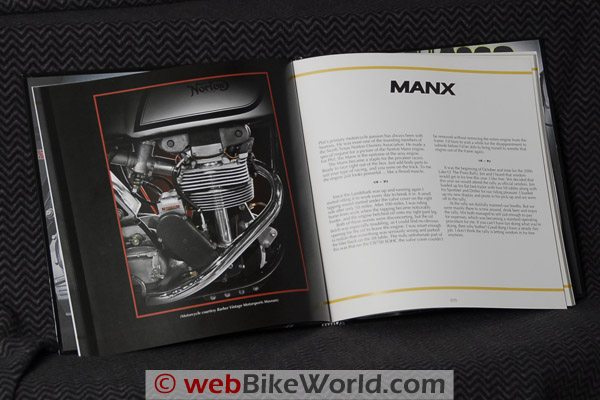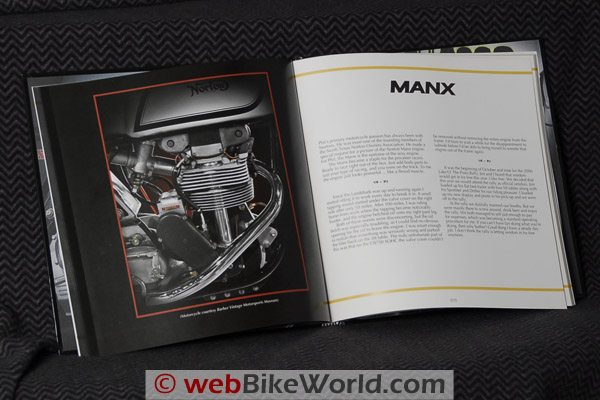by: Daniel Peirce
Veloce Publishing, August 2008
Hardcover, 144 Pages, Color Photos and Text
ISBN: 978-1-84584-174-4
Price: $39.95 or £19.99
by “Burn” for webBikeWorld.com
More: wBW Reviews Home | Book Reviews Index | Owner Comments (Below)
I’m a gearhead, no two ways about it.
I came to this realization back in the early ’50’s in the same way that a kid might suddenly realize that he has 6 toes, while everyone else has 5. It was something that marked me and was part of me and I accepted it and knew would be with me forever.
The funny thing is, I distinctly remember the instant it happened. I was standing on a toolbox, peering under the hood of Uncle Tony’s ’52 Oldsmobile. A Super 88. It was black, as black as the hair on his head and the grime under his fingernails.
Uncle Tony and his friend Moishe had pulled the single carb from the 303 cubic inch V8 sitting in the driveway of our Brooklyn home.
My memory is fading, but I believe they were fitting a “tri-power” three-carb manifold to the Rocket V8. Kids didn’t say much in those days, and adults didn’t talk to them, but Tony glanced over and winked at me and went back to work, burying his hands up to his elbows.
I stood there in awe of that mighty Rocket engine as the musty smell of thick wool seat covers played in the background and smothered me with goodness. I looked at the rat’s nest of fuel lines woven through both their hands when it hit me — the engine was the heart of this beast, the only thing that mattered.
I have that same awesome feeling to this day whenever I see a powerplant of any type. Engines are simply amazing in every shape and form; I often fall asleep dreaming of the new intake systems I would design.
So when I heard about The Fine Art of the Motorcycle Engine, I knew I had to get a copy as soon as possible. The book is just entering the North American distribution pipeline, but I ordered mine from England, hot off the press, so I could have it sooner.
This is a coffee table book in a square format with color photos of 64 different rare, classic or noteworthy motorcycle engines. It is an outcome of something called “The Up-N-Smoke Engine Project”; an endeavor I don’t really understand even after reading the book or the marketing collateral…but apparently was a series of motorcycle engine photos that were turned into prints and hung on the walls of a barbeque joint of the same name.
It all sounds good so far, and an engine guy like me should be pleased as punch, right? But there’s a problem — or a couple of ’em, actually. While the square format shouldn’t really matter, I think the photos are cropped too tightly to fit, and the squares don’t provide enough room around the edges to draw in the eye.
The author didn’t use a square format camera; nor did he use a digital SLR. He used a Nikon Coolpix 8700, of all things — which would certainly not be my camera of choice for a project like this, for a number of reasons.
Another problem has to do with the printing, which was done in India. Nothing at all against Indian printers, but the publisher may have tried to squeeze a few too many rupees, because the quality of the paper and the reproductions aren’t quite up to archival standards.
But the worst part is that many of the photos were “over-Photoshopped”. I am (was) a photographer by trade, so maybe I’m more sensitive to this than the average book lover, but I noticed right away that many of the photos have too much contrast; the edges on some look unnatural as a result of the cropping out of the background; yet the reflections of the background can be seen in some of the chrome, but those reflections don’t match the faked “studio” lighting.
The contrast and heavy post-processing are especially obvious in the engines with a lot of chrome, like the Honda 400F, the Gold Star, the BMW R12, the Duo-Glide, the Tiger Cub and others. The photos that are more evenly exposed are much better, but the photos that were taken outdoors and then modified to appear to have been taken in a studio suffer from the conversion process, in my opinion.
I think anyone who has slightly more than a passing knowledge of Photoshop should recognize right away that these photos are over-processed. Some of this may have to do with the camera; my feeling is that the use of the Coolpix 8700 probably limited some of the resolution and range before the post-processing even started.
I think this all gives the majority of the engines a weird half-real, half-fake look that may not be immediately obvious to everyone, but which I think makes the photos look, well, doctored, especially in the highlights and high-contrast edges. This is really a shame, and I think the author would have been better off giving us less Photoshop and more reality instead. The presentation just seems to give these beautiful engines a look that is too clinical for my taste.
By the way, the author is upfront about the post-processing — he’s devoted a few pages at the end to show how he took the photos, cropped them and used Photoshop to prepare them for publication.
Another issue I have has to do with the descriptions of the engines. Open a page and each engine photo on the left has a matching one-page description on the right, but the descriptions don’t include all that much about the history or technical specifications or interesting engineering features of the engine — they’re mostly a running dialog on topics like how the author found the motorcycle, the owner and other narrative that, to me, is disappointing because it isn’t focused on the subject, although I may be in the minority on this nitpick, I’ll admit.
I guess I’m being pretty critical here, but this is a book review and a review is an opinion and my opinion is that I’m disappointed. 40 bucks is a lot of money to spend on a book with picture of engines; I assumed I’d be able to study the photos to learn more about how the engines were built and read some narrative about their design.
Maybe the casual reader won’t notice, and if you just want an art book with some admittedly interesting photos of a variety of motorcycle engines, this volume may do the job, but I’m afraid that not many art lovers are going to be interested in this topic.
Engine freaks like me are, however, but I can’t get beyond the too-tight cropping, the too-obvious Photoshop post-processing and what I think is the wrong focal length used to capture many of the images. Sorry, but that’s the way I feel about it!
wBW Rating:
More: wBW Book Reviews Index & the “Flaming Helmet” Rating System | All Reviewed Books Ranked by Rating
Note: For informational use only. All material and photographs are Copyright © webWorld International, LLC – 2000-2013. All rights reserved. See the webBikeWorld® Site Info page. NOTE: Product specifications, features and details may change or differ from our descriptions. Always check before purchasing. Read the Terms and Conditions!
Owner Comments and Feedback
See details on submitting comments.
From “G.A.M.” (9/08): “I appreciate this review, and I don’t think the reviewer is being too picky. If I am purchasing a book about the ART of something related to the motorcycle, I would expect superior photography, as well as some real technical information about what is unique about the engines. Ok, I understand that “art” related to a motor might be perceived as being only visual, I think that cheapens the Art of a Motorcycle.
A couple of years ago, I was privileged to attend “The Art of the Motorcycle”, the Guggenheim’s travelling exhibit that originated in New York City, during a business trip to Memphis. The NYC exhibit broke all previous attendance records for the museum, which says a LOT about motorcycles and the public’s interest in them.
I spent 5 and a half hours there, and as we were leaving, the security guard told me that my companion and I broke the previous record for time in the exhibit, buy a full two hours. One reason was because I had two cameras with me, and I exhausted the batteries in both of them before I left. I also purchased the exhibit book, which included some very good studio photography, depicting the motorcycle as art. My photos were remembrances, the official photos were art.
So I would like to support the reviewers concern about the quality of the photography, and the quality of the text. Bikes can be a work of art visually, and mechanically, and I would be disappointed to not have the best of both in a $40 book.”



